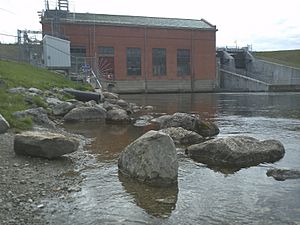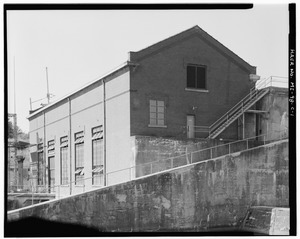Cooke Dam facts for kids
Quick facts for kids Cooke Dam |
|
|---|---|

Cooke Dam
|
|
|
Location within the state of Michigan
|
|
| Location | Oscoda Township, Iosco County, Michigan |
| Coordinates | 44°28′22″N 83°34′18″W / 44.472669°N 83.571677°W |
| Construction began | 1911 |
| Dam and spillways | |
| Type of dam | Embankment dam |
| Power station | |
| Installed capacity | 9 MW |
|
Cooke Hydroelectric Plant
|
|
| Nearest city | Oscoda, Michigan |
| Area | 4 acres (1.6 ha) |
| Built | 1912 |
| Architect | William Gilbert Fargo, James Berry Foote |
| Architectural style | Classical Revival |
| NRHP reference No. | 96000803 |
| Added to NRHP | August 2, 1996 |
The Cooke Dam is a special kind of dam that uses water to make electricity. It's located on the Au Sable River in Michigan. This dam is so important that it was added to the National Register of Historic Places in 1996, which means it's a historic site worth protecting. It's officially known as the Cooke Hydroelectric Plant.
Contents
How the Cooke Dam Was Built
The story of the Cooke Dam begins with a smart businessman named William Augustine Foote. He started many electric companies in Michigan. In 1899, he came up with a new idea: sending electricity over long distances using high-voltage lines. He sent power 22 miles from one dam to Kalamazoo!
Foote really wanted to use the Au Sable River to make power because its water flows steadily. But he needed a lot of money to do it. Later, he helped build the Croton Dam, which sent power even further, 40 miles, using very high voltage. In 1909, Foote combined his companies with others to form Consumers Power Company.
With the support of Consumers Power, Foote went back to the Au Sable River in 1909. He found three good spots for hydroelectric dams. The first spot, where the Cooke Dam now stands, was suggested by a banker named Andrew Cooke. He helped get the money for the project, and that's why the dam is named after him!
A big camp was set up in 1909 for all the workers building the dam. They first changed the river's path. By mid-1910, the base of the dam was ready.
Making Electricity and Setting Records
The Cooke Dam started making electricity in December 1911. It could make 9,000 kilowatts of power. The electricity was sent 125 miles away to Flint. The voltage used was 140,000 volts, which was a world record at the time!
New ideas were used for this project. They built special towers that looked like windmills to hold the power lines. They also made better insulators, which are materials that stop electricity from escaping. The Cooke plant was the first of six dams built on the Au Sable River over the next 12 years.
Today, the Cooke plant still makes power, but at a lower voltage of 46,000 volts. The original machines are still working! The Cooke Hydro plant is also part of the River Road Scenic Byway, a special road known for its beautiful views.
What the Cooke Hydroelectric Plant Looks Like
The Cooke Hydroelectric Plant is made up of several parts along the Au Sable River. The main dam has an earth wall on each side. These walls connect to a spillway, which is where extra water can flow out. Next to the spillway are the powerhouse and an outdoor substation. There are also two other buildings nearby: a house for the dam's attendant and a storage shed.
Dam Walls and Spillway
The two earth walls of the dam create a V-shape across the river. The north wall is 572 feet long and made of earth. It has a 12-inch thick concrete wall on the side facing the water to make it stronger. The south wall is similar but only 90 feet long.
The spillway has three large steel gates called Tainter gates. These gates are only opened when there's a lot of water, like during a flood. Normally, all the river water flows through the powerhouse to make electricity.
Powerhouse and Substation
The powerhouse is a building made of red brick with a green tile roof. It is about 116 feet long and 67 feet wide. It has five windows on the front, with flat brick arches above them. There are also doors for people and for moving equipment.
Inside, the powerhouse is mostly one big open space. It has a basement and an upper level. Most of the space is taken up by the generators and their controls. The generators are connected to turbines, which are like big spinning wheels, in a nearby water channel.
Next to the powerhouse is the outdoor substation. This is a concrete area with transformers and other equipment. A fence surrounds the substation to keep it safe.
Attendant's House
The attendant's house is a two-and-a-half-story wooden building. It has a pointed roof at the front. It was built around 1909 so that the dam operators could live right there. This was important because the dam was in a very isolated area back then. To get to the dam, you had to travel 18 miles by wagon or 160 miles by a small logging train.
The house has a front porch with a triangular roof. It also has small windows sticking out of the roof and decorative parts under the main roof. These details make it look like the Classical Revival style of architecture. The porch used to have round columns, but they were removed when the porch was closed in.
Storage Shed
The storage shed is a one-story wooden building. Its sides are covered with vertical boards and strips. It has two large doors on the front. This shed was probably part of the original camp built for the workers who constructed the dam.







